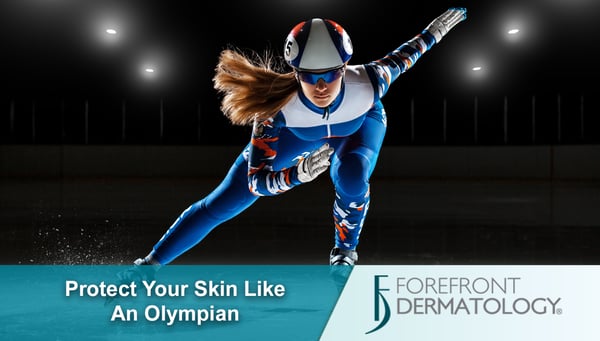
While the world is tuned into the fresh powder and frozen ice at the PyeongChang 2018 Winter Olympics, we may find ourselves asking questions about these athletes. How do can they do that? How many years of dedication did it take? How do they stay in such great shape?
The one question we don’t ask ourselves, but should, is how does their skin look so great out in that cold? As an Olympic watcher it’s important to recognize the risks these athletes have exposing their skin to winter conditions and how they protect it.
Sunburn and Windburn
From skiing and snowboarding, to ice skating and bobsledding or even shoveling your driveway, all outdoor winter activities put you at risk for sunburn and windburn. It’s a common misconception that windburn is its own condition, but in reality it’s actually sunburn resulting from prolonged exposure to the sun and wind. Because of the chill in the air, you might not even consider that sunburn is a risk you should worry about. The UV exposure is strong year-round and increased when snow is on the ground for it to bounce off of.
According to Dr. J. Mark Jackson, board-certified dermatologist for Forefront Dermatology, “sun exposure is the most preventable risk factor for skin cancer. Apply a broad-spectrum sunscreen to any part of your skin that’s not covered by clothing. Don’t forget your lips either! They take a beating in the colder and are usually the last part we cover up. Regularly apply a lip balm with SPF 30 or higher regardless of whether you are indoors or out.”
Frostbite
You may have noticed while watching the Olympics or even football this past season that red faces were showing on athletes and fans alike. Frostbite occurs when the skin, and sometimes the tissue beneath the skin, freezes due to prolonged exposure to cold temperatures. Depending on how long and how frozen the tissue, frostbite can result in severe and sometimes permanent damage. It doesn’t take sitting through an entire football game or Olympic competition to start being affected by frostbite. Even shoveling snow can bring it on if you’re out there too long and not properly protected.
“To protect your skin against frostbite dress in loose layers to trap warm air and hold it against the body,” noted Dr. Jackson. “Consider wearing more than one pair of socks, a warm hat that covers your head and ears, and wrap a scarf over your mouth to warm the air you breathe. It is important wear a very good pair of insulated gloves since your fingers will be one of the first areas on the body to become cold.”
Blisters
Just because you are out in the cold doesn’t mean you won’t sweat. Blisters can form when there’s too much friction against the warm, moist skin. When it comes to winter sports and outdoor duties, this can be caused by anything from boots that don’t fit properly to winter athletic equipment. To prevent blisters, it’s best to make sure there’s enough room between your protective clothing layers and your skin. Don’t wear tight-fitting clothes or boots.
Skin Struggles?
If you are struggling with skin issues and don’t know where to turn, the skin health experts at Forefront Dermatology are ready to help. To find the Forefront dermatologist nearest you, visit the locations page today.





